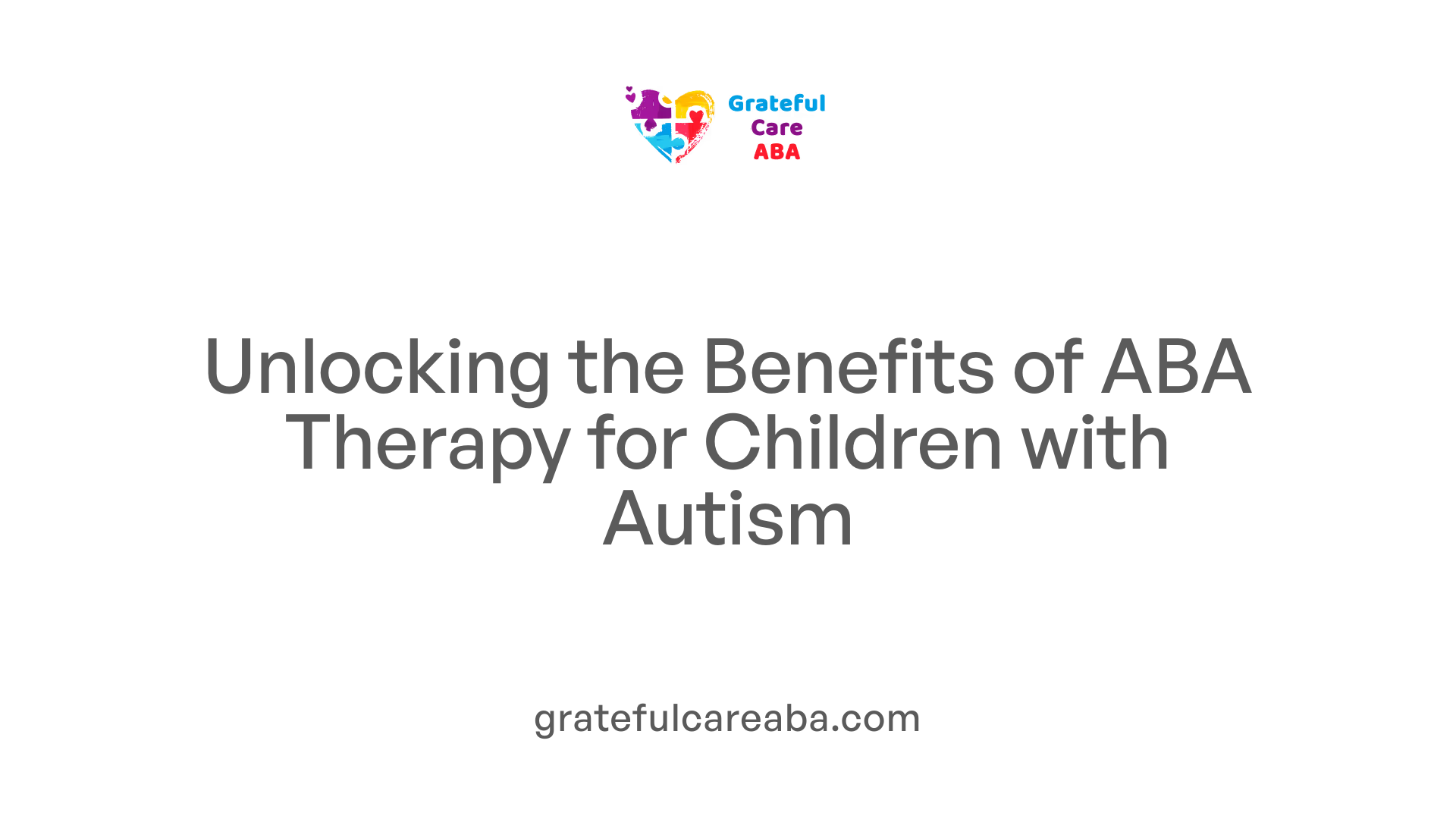How ABA Therapy Supports Children with Autism
Understanding ABA Therapy's Role in Autism Support


Exploring ABA Therapy
Applied Behavior Analysis (ABA) therapy is widely recognized as one of the leading methods for supporting children with autism. With its roots in scientific study, ABA therapy is a structured program that focuses on improving specific behaviors by reinforcing positive actions while reducing negative ones. This article delves into how ABA therapy benefits children with autism, examining its methodologies, advantages, and the controversies that surround it.
The Fundamentals of ABA Therapy

What is ABA therapy and how does it help children with autism?
Applied Behavior Analysis (ABA) is a scientifically grounded approach designed to improve behaviors in children with autism spectrum disorders (ASD). This therapy focuses on identifying and enhancing beneficial behaviors while decreasing harmful ones through customized treatment plans tailored to meet each child's individual needs and goals.
ABA employs strategies such as positive reinforcement, which incentivizes the repetition of desired behaviors. By utilizing techniques rooted in behavioral science, ABA encourages skill development across various domains, including communication, social interactions, and academic performance. Extensive research has consistently validated ABA as an effective, evidence-based practice, demonstrating its positive impacts on children with ASD.
Purpose and methodology
The primary purpose of ABA therapy is to foster independence and enhance quality of life for children with autism. This is achieved through the use of structured interventions that break down complex skills into manageable steps. Frequent progress assessment enables therapists to modify techniques based on individual achievements, ensuring the therapy remains relevant and effective.
Techniques involved
ABA therapy encompasses various techniques that support individualized learning. Here are some key methods used in ABA practices:
| Technique | Description | Purpose |
|---|---|---|
| Discrete Trial Training (DTT) | Involves breaking down tasks into small, repeatable components. | Systematically teaches skills through repetitive practice. |
| Natural Environment Training (NET) | Leverages everyday situations to reinforce learning. | Ensures skill application in real-life scenarios. |
| Functional Behavior Assessment (FBA) | Evaluates strengths and needs to develop targeted interventions. | Creates personalized treatment plans. |
| Pivotal Response Training (PRT) | Conducted in natural settings, emphasizing pivotal behaviors. | Encourages development of multiple related skills. |
These techniques underline the individualized nature of ABA therapy, allowing for a tailored approach that directly addresses each child's strengths and challenges.
Beyond Autism: The Versatility of ABA Therapy

Is ABA therapy used only for autism?
ABA therapy is not exclusively linked to autism spectrum disorder (ASD). It’s a versatile approach that effectively addresses various behavioral and learning issues. While it is most recognized for its application in autism treatment, ABA techniques can also benefit children with conditions such as ADHD, OCD, ODD, PTSD, and even those without any diagnosed behavioral disorders.
What other conditions can ABA therapy address?
The foundational strategies of ABA therapy, particularly positive reinforcement, promote positive behavior changes across diverse contexts. Here are some conditions where ABA techniques are applicable:
| Condition | Description | ABA Focus |
|---|---|---|
| ADHD | Attention Deficit Hyperactivity Disorder | Encouraging focus and impulse control |
| OCD | Obsessive-Compulsive Disorder | Reducing compulsive behaviors |
| ODD | Oppositional Defiant Disorder | Improving compliance and social skills |
| PTSD | Post-Traumatic Stress Disorder | Addressing emotional responses and triggers |
| General Learning | Learning issues in neurotypical children | Classroom management and social interactions |
How flexible are ABA strategies?
The flexibility of ABA strategies allows them to be tailored to the specific needs of individuals. Although insurance coverage often focuses on autism diagnoses, research shows that ABA techniques can assist with a broader range of behavioral issues. As a result, parents and educators find ABA therapy beneficial for addressing various challenges beyond autism, enhancing overall behavior and learning outcomes in diverse settings.
Techniques and Methodologies in ABA

What are some techniques and examples used in ABA therapy?
ABA therapy employs a variety of techniques aimed at enhancing learning and behavioral skills tailored to each child’s unique needs. Some of the most effective techniques include:
- Discrete Trial Training (DTT): This method breaks down skills into manageable, teachable steps through repeated practice, providing clear instructions to support learning.
- Natural Environment Teaching (NET): Unlike DTT, NET focuses on teaching in the child’s natural surroundings, encouraging them to apply learned skills in daily activities.
- Reinforcement Systems: Both positive and negative reinforcement strategies are pivotal. Positive reinforcement encourages desired behaviors by rewarding them, while negative reinforcement helps to discourage inappropriate actions.
- Modeling and Role-Playing: These techniques allow children to observe and practice positive behaviors, making abstract social cues more concrete and understandable.
- Prompting and Fading: Depending on the child’s progress, prompts (like verbal cues) are intentionally reduced over time to foster independence.
How are these techniques applied in real-life settings?
The versatility of ABA methods allows the acquisition of skills that are crucial for everyday life. For instance:
- Social Stories: Useful for teaching complex social interactions, this technique presents scenarios children might face, helping them navigate social cues effectively.
- Video Modeling: Showing children videos of positive interactions can illustrate appropriate behaviors in various situations, making learning more relatable.
- Functional Behavior Assessment (FBA): This process identifies triggers and reinforces new, positive behaviors, ensuring strategies are reflective of real-life challenges.
By implementing these techniques, ABA therapy not only promotes skill development within controlled environments but also prepares children to apply these skills in real-world situations, ultimately enhancing their quality of life.
Benefits of ABA Therapy for Autistic Children

What are the potential outcomes and advantages of ABA therapy for children with autism?
ABA therapy offers significant advantages for children with autism, focusing on enhancing essential skills while reducing undesired behaviors. Studies and years of research support its effectiveness in improving communication, social interactions, and learning abilities.
Key Outcomes of ABA Therapy:
- Improved Communication Skills: By utilizing techniques like Verbal Behavior therapy and the Picture Exchange Communication System, children develop the ability to express needs and understand language better.
- Social Skills Improvement: Methods such as role-playing and modeling appropriate behaviors help children learn how to interact positively with peers and respond to social cues.
- Behavioral Development: Techniques such as Discrete Trial Training (DTT) break down complex tasks into manageable steps, allowing for gradual learning and mastery of new skills.
Despite some critique, modern ABA focuses on fun and engagement, ensuring that therapies are child-centered and relevant to their interests. To maximize these benefits, early intervention is crucial.
Importance of early intervention
Starting ABA therapy at a young age can be transformative, especially when initiated before age six. A significant portion of children receiving intensive early intervention sees large developmental gains. Leveraging a structured approach that includes both supervised sessions and natural environment teaching leads to greater independence and self-regulation skills.
In conclusion, ABA therapy is a potent tool not only for behavioral change but also for fostering essential life skills—ensuring children with autism can thrive in everyday environments.
Controversies and Ethical Considerations

Is ABA therapy harmful and what are the associated ethical considerations and controversies?
ABA therapy has garnered both praise and criticism, making ethical considerations a crucial part of discussions regarding its application. Critics of traditional ABA raise concerns about past practices which sometimes utilized punishment as a method of behavior modification. This history has shaped perceptions and generated fears that such approaches might harm autistic individuals by ignoring their emotional needs and authentic expressions.
Moreover, the intensity and "one-size-fits-all" model of some ABA interventions have sparked debates. Critics argue that these characteristics may overlook the diversity of the autism spectrum, failing to respect individual differences and personal agency. On the other hand, proponents assert that contemporary ABA is grounded in positive reinforcement, aiming to empower rather than diminish the individual's uniqueness.
As the field evolves, the emphasis on tailoring interventions to each child's specific needs highlights a critical development. Supporters advocate for a respectful balance, where the goal remains to enhance behaviors conducive to independence while honoring the dignity and individuality of those with autism. Continuous dialogue on ethical frameworks is essential to ensure that ABA therapy remains beneficial and respectful.
Implementing ABA Therapy: Real-World Impact
Role of Early Intervention
Early intervention in Applied Behavior Analysis (ABA) therapy is crucial for maximizing developmental outcomes in children with autism spectrum disorder (ASD). Starting therapy before the age of six can lead to significant improvements in communication, socialization, and overall behavior. Studies have shown that children who receive early and intensive ABA therapy typically demonstrate better adaptability in social settings and greater independence as they grow.
In fact, systematic research indicates that early and comprehensive ABA interventions, like the Early Start Denver Model (ESDM), yield medium to large positive effects on communication skills and adaptive behaviors. The sooner children engage with this evidence-based approach, the more likely they are to develop essential life skills that promote their independence in various settings.
Collaborative Approaches with Families and Educators
Successful implementation of ABA therapy relies heavily on collaboration between therapists, families, and educators. By working together, families can reinforce learned skills at home while educators adopt consistent strategies in the classroom, easing the transition for the child. This team approach fosters an environment where behaviors can be supported across different contexts.
Involving parents and caregivers in the process helps nurture positive reinforcement techniques, encouraging the child to apply learned skills in real-life situations. This synergy not only enhances the effectiveness of ABA therapy but also empowers families by providing them with practical strategies to facilitate their child’s growth and development.
| Aspect | Early Intervention | Collaborative Approaches |
|---|---|---|
| Focus | Maximize development | Consistency in strategies |
| Outcomes | Better adaptability | Improved family engagement |
| Method | Intensive and early | Team-based support |
The Future of ABA Therapy in Autism Care
As we continue to learn more about autism and effective interventions, ABA remains a cornerstone in evidence-based treatment strategies. Its continued evolution focuses on aligning therapeutic methods with the individual needs and dignity of the autistic community. By incorporating family and community into treatment plans, ABA therapy aims to provide holistic support that enhances the quality of life for children with autism. As debates on its methodologies and ethical considerations continue, the fundamental goal remains to offer compassionate and skillful guidance towards a brighter future for those on the spectrum.
References
- 6 Life-Changing Benefits of ABA Therapy for Children with Autism
- Applied Behaviour Analysis (ABA) and autistic children
- Applied Behavior Analysis in Children and Youth with Autism ...
- Questions and answers about ABA | Autism Speaks
- Common ABA Therapy Strategies for Children With Autism
- Why Does ABA Help Children With Autism? - LeafWing Center
- Treatment and Intervention for Autism Spectrum Disorder - CDC
- How ABA Therapy Supports Children with Autism
- How ABA Therapy Can Improve Your Child's Life
Apply Now
At Grateful Care ABA, we are proud to offer the best ABA therapy services in Indiana. Armed with a team of skilled Board Certified Behavior Analysts (BCBAs), we bring years of experience to the table, making us the preferred provider for ABA therapy in our community.
Understanding that every child with ASD is unique and has unique goals and objectives, our ABA therapists carefully craft personalized ABA therapy plans that are tailored to meet the specific needs of each child. Whether your child needs help with reducing maladaptive behaviors, your child needs IEP support at school, you want your child to be self-sufficient at home, or something else, we use ABA therapy to work diligently toward specific goals. Together we can make a difference in your child’s life!
Contact us today to connect with an ABA therapist and learn more about ABA therapy solutions for your child.

































































































